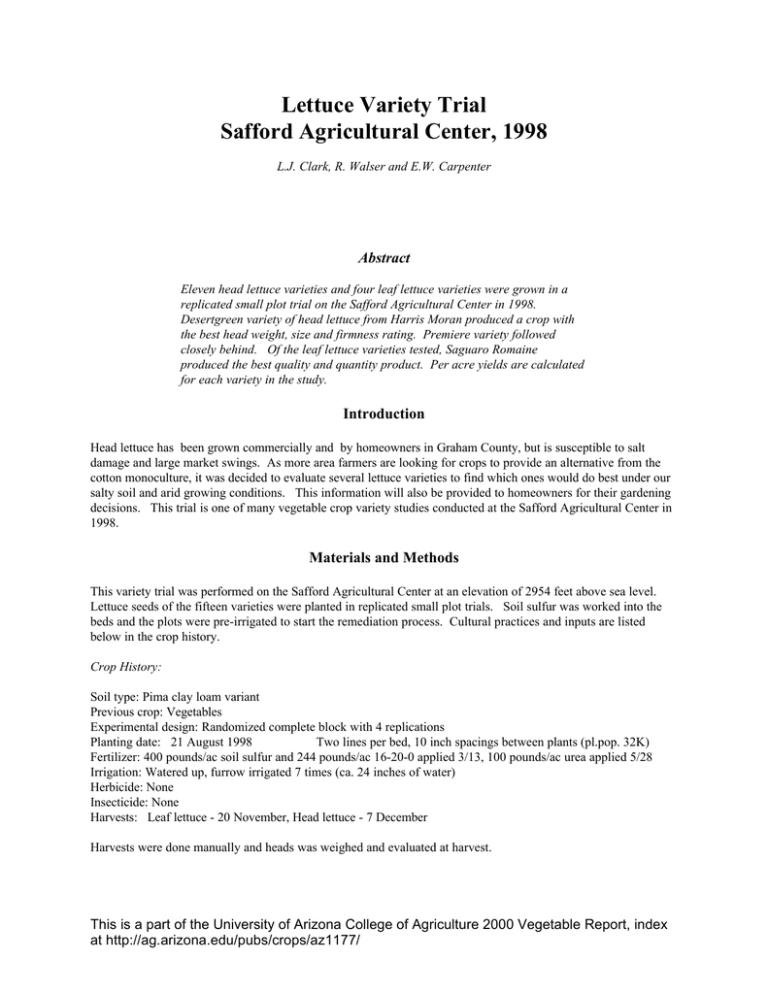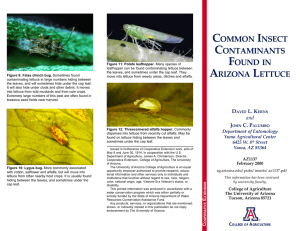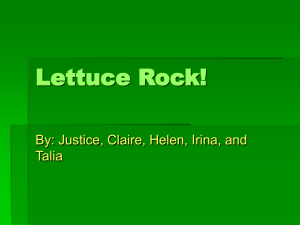Lettuce Variety Trial Safford Agricultural Center, 1998 Abstract
advertisement

Lettuce Variety Trial Safford Agricultural Center, 1998 L.J. Clark, R. Walser and E.W. Carpenter Abstract Eleven head lettuce varieties and four leaf lettuce varieties were grown in a replicated small plot trial on the Safford Agricultural Center in 1998. Desertgreen variety of head lettuce from Harris Moran produced a crop with the best head weight, size and firmness rating. Premiere variety followed closely behind. Of the leaf lettuce varieties tested, Saguaro Romaine produced the best quality and quantity product. Per acre yields are calculated for each variety in the study. Introduction Head lettuce has been grown commercially and by homeowners in Graham County, but is susceptible to salt damage and large market swings. As more area farmers are looking for crops to provide an alternative from the cotton monoculture, it was decided to evaluate several lettuce varieties to find which ones would do best under our salty soil and arid growing conditions. This information will also be provided to homeowners for their gardening decisions. This trial is one of many vegetable crop variety studies conducted at the Safford Agricultural Center in 1998. Materials and Methods This variety trial was performed on the Safford Agricultural Center at an elevation of 2954 feet above sea level. Lettuce seeds of the fifteen varieties were planted in replicated small plot trials. Soil sulfur was worked into the beds and the plots were pre-irrigated to start the remediation process. Cultural practices and inputs are listed below in the crop history. Crop History: Soil type: Pima clay loam variant Previous crop: Vegetables Experimental design: Randomized complete block with 4 replications Planting date: 21 August 1998 Two lines per bed, 10 inch spacings between plants (pl.pop. 32K) Fertilizer: 400 pounds/ac soil sulfur and 244 pounds/ac 16-20-0 applied 3/13, 100 pounds/ac urea applied 5/28 Irrigation: Watered up, furrow irrigated 7 times (ca. 24 inches of water) Herbicide: None Insecticide: None Harvests: Leaf lettuce - 20 November, Head lettuce - 7 December Harvests were done manually and heads was weighed and evaluated at harvest. This is a part of the University of Arizona College of Agriculture 2000 Vegetable Report, index at http://ag.arizona.edu/pubs/crops/az1177/ Analyses from saturated paste extracts from the experimental field and a typical water sampling from the irrigation well are included below: Sample pH Electroconductivity Total Dissolved Solids ppm Na Estimated SAR Soil 0-2 inches 7.81 6.42 4109 1020 9.9 Soil 6-8 inches 8.34 1.86 1190 322 6.0 Well water 7.53 2.06 1318 366 7.35 Results and Discussions Lettuce is moderately salt sensitive (1) with a salinity threshold value for electroconductivity of 1.7 and a slope of 13. Using the formula Yr = 100 - B(Ke - A), where Yr is the relative yield, A is the salinity threshold, B is the slope or percent yield decrease per unit salinity increase above the threshold and Ke is the electroconductivity of the saturated soil paste, the yield potential for lettuce under field conditions can be calculated. With these values it is determined that Yr (0 - 2") = 38.6% and Yr (6-8") = 97.9%. This shows the importance of scraping off the tops of he beds to plant in less salty soil and irrigating every other row to push the salts away from the plant roots. The top part of Table 1 gives information on the 11 head lettuce varieties. Desertgreen variety from Harris Moran produced the largest, heaviest head and it also had the best firmness rating. Premiere produced the next largest yield and it, too, had head qualities better than the rest of the field of varieties. The yield of 384 hundredweights per acre for Desertgreen was calculated from the head weight multiplied by 32,000 plants per acre. (The lettuce was planted on two lines on a 36 inch bed, with an average spacing of 10 inches between plants in a line.) Inspite of the fact that salt in the soil could supress yields, the top two varieties produced yields comparable with most places in the country. Lorenz and Maynard (2) report that the average lettuce yield in the United States is 280 hundredweights per acre and 400 hundredweights per acre is considered a good yield. The bottom part of the table provides information on the leaf lettuce varieties studied. Saguaro Romaine produced a yield superior to the other varieties tested. Two of the varieties had bolting problems and in the case of Deep Red the problems were severe. Yields for the leaf lettuce were calculated in the same manner as the head lettuce. Lettuce can be commericially grown in the area, but caution must be taken to plant in fields where the salt problems are low or where they can be controlled by remediation. The nearest infrastructure base for lettuce is Willcox, approximately 50 miles away. The biggest challenge in producing lettuce is marketing. References 1. Maas, E.V. 1986. Salt tolerance of plants. Applied Agricultural Research Vol. 1, No. 1, pp. 12-16. SpringerVerlag New York. 2. Lorenz, O.A. and D.N. Maynard. 1988. Knott’s Handbook for vegetable growers, third edition. WileyInterscience Publication, New York. Table 1. Lettuce harvest quality and yields by varieties grown at the Safford Agricultural Center, 1998. Variety Head weight (lbs) Head size (diameter inches) Yield (Cwt/acre) Head firmness1 Bolting2 Head Lettuce Desertgreen 1.20 a3 4.6 a 384 4.6 a -- Premiere 1.00 ab 4.4 a 320 4.5 a -- Valley Green 0.95 ab 4.1 a 304 4.2 a -- Valley Queen 0.94 ab 4.1 a 301 4.1 a -- Alpha DMR 0.93 ab 4.2 a 298 3.5 a -- Van Fall 0.90 b 4.2 a 288 4.0 a -- Coolgreen 0.89 b 4.3 a 285 3.5 a -- Sun Devil 0.89 b 4.0 a 285 4.1 a -- Maxium 0.88 b 4.1 a 282 4.5 a -- Fall Green 0.74 b 3.8 a 237 3.7 a -- Gilaben 0.73 b 3.8 a 234 4.1 a -- Average 0.91 4.1 292.5 4.1 -- LSD(05) 0.28 0.8 -- 1.1 -- CV(%) 21.2 13.2 -- 18.8 -- Leaf Lettuce Saguaro Romaine 1.03 a 8.7 a 330 -- -- Deep Red 0.67 b 7.9 ab 214 -- 4.0 Tania Butterhead 0.59 b 6.3 b 189 -- -- Ruby Ruffle 0.48 b 7.6 ab 154 -- 1.3 Average 0.069 7.6 221.8 -- -- LSD(05) 0.26 1.8 -- -- -- CV(%) 24.0 15.0 -- -- -- 1. Firmness rating: 1 = soft, 5 = hard. 2. Bolting rating: 1 = No bolting, 5 = 100% bolting. 3. Values within a column followed by the same letter are not significantly different at the 95% level of confidence using Duncan’s Multiple Range test.



